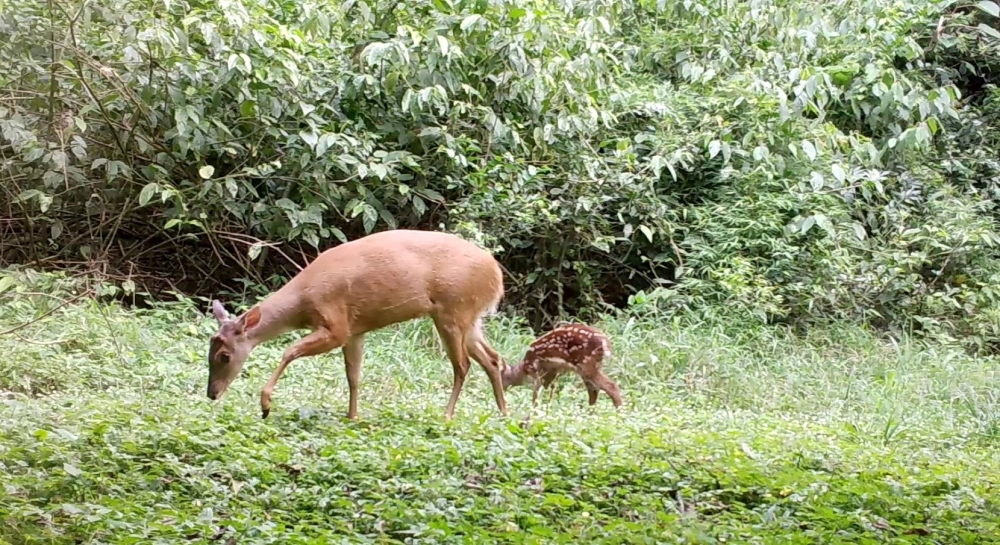


The Southern red brocket (Mazama rufa), one of three deer species native to the Atlantic Rainforest, is highly vulnerable to human activity (photo: Projeto Onças do Iguaçu)
Published on 11/28/2022
By André Julião | Agência FAPESP – Highly dependent on forests, targeted by poachers and attacked by domestic dogs and cattle diseases, the deer that live in Brazil’s Atlantic Rainforest biome are mostly vulnerable to extinction. The good news is that extending protection to an additional 48,400 square kilometers (km²), or 2% of the biome, could be sufficient to maintain the populations of the three Brazilian deer species that live in these forests. Only about half the areas concerned are at all protected by law.
This is the gist of an article published in the Journal for Nature Conservation and signed by Brazilian researchers supported by FAPESP.
“They’re strictly forest-dwelling species, and their presence is an important indicator of quality for Atlantic Rainforest areas, so by conserving the deer we’ll also protect the entire ecosystem,” said Márcio Leite de Oliveira, who conducted the study during a postdoctoral internship at São Paulo State University's Deer Conservation Center (NUPECCE-UNESP) in Jaboticabal, with a scholarship from FAPESP.
His co-authors are researchers at the Federal University of Paraná (UFPR) and the Federal University for Latin American Integration (UNILA) in Foz do Iguaçu, Paraná state.
According to the article, 56.8% of the areas that should be priorities for protection are not in conservation units.
The rest are in biological reserves and national parks, which are strictly controlled (20.7%), or Environmental Protection Areas (APAs), which are less so (19.9%). A small proportion (2.6%) are in Indigenous territories.
To arrive at these numbers, the researchers mapped all the Atlantic Rainforest areas inhabited by the Southern red brocket (Mazama rufa), Small red brocket (Mazama jucunda) and Pygmy brocket (Mazama nana) in Brazil, Argentina and Paraguay.
Criteria
The mapping exercise focused on forests and viable bioclimate conditions. The researchers defined the minimum area for survival as 120 km². Areas considered theoretically adequate for the animals but where they had not actually been detected were added to the map. “We couldn’t be sure whether species were there or not, so these areas were given lower weightings,” Oliveira said.
The researchers also observed that many areas, even in conservation units, were impacted by human activity, such as hunting, and the presence of exotic species, such as domestic dogs used by poachers, as well as pigs, cows, sheep and boars, all of which can transmit disease.
Half the area proposed as a priority was significantly influenced by human activity and the rest less so. Public policy for deer conservation should take these differences into account, they note.
In heavily human-influenced areas outside conservation units, they recommend the creation of APAs or similar protected areas in which certain sustainable uses could be allowed. For areas with less human influence, they propose the establishment of more restrictive units, such as parks and reserves.
“We identified 21 large forests outside protected areas that could sustain viable deer populations and could be converted into new conservation units,” Oliveira said.
Although the level of protection in some conservation units is lower, the existence of legal protection would necessarily make environmental licensing of infrastructure projects more rigorous, safeguarding deer at least to some extent.
The researchers hope the mapping exercise will provide administrators and communities with a sound basis for conservation of deer and, by extension, the ecosystems they inhabit.
The study was also supported by FAPESP via a doctoral scholarship awarded to Pedro Henrique de Faria Peres.
New genus
The NUPECCE group led by José Maurício Barbanti Duarte, a professor at UNESP School of Agricultural and Veterinary Sciences (FCAV) in Jaboticabal, has researched South American deer for decades (read more at: agencia.fapesp.br/37739).
As a result of this research, some deer groups have been reclassified. Red brockets, for example, previously considered a single species (Mazama americana) are now viewed as a complex that includes Mazama rufa, mentioned above and recently revalidated.
More recently, the group brought back the genus Subulo, originally described in 1827 and later considered synonymous with Mazama. In a paper published in the Journal of Mammalogy, they removed the Gray brocket from Mazama and renamed it Subulo guazoubira. The species inhabits the Caatinga (the semi-arid biome in Northeast Brazil) and Cerrado (savanna) including areas reforested after environmental degradation (cerradão).
This study resolved one more piece of the complex evolutionary jigsaw puzzle concerning South American deer. It was supported by FAPESP via two projects (17/07014-8 and 19/06940-1).
The article “Using niche modelling and human influence index to indicate conservation priorities for Atlantic Forest deer species” is at: www.sciencedirect.com/science/article/abs/pii/S1617138122001352.
The paper redescribing Subulo is at: academic.oup.com/jmammal/advance-article-abstract/doi/10.1093/jmammal/gyac068/6702645.
Source: https://agencia.fapesp.br/40179